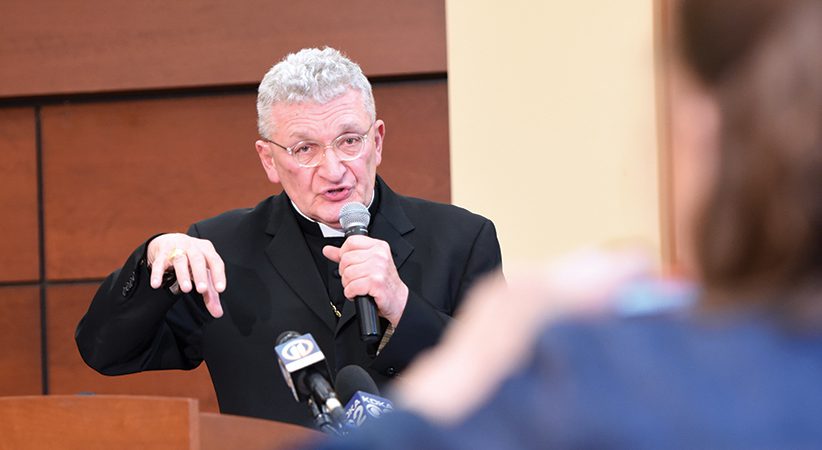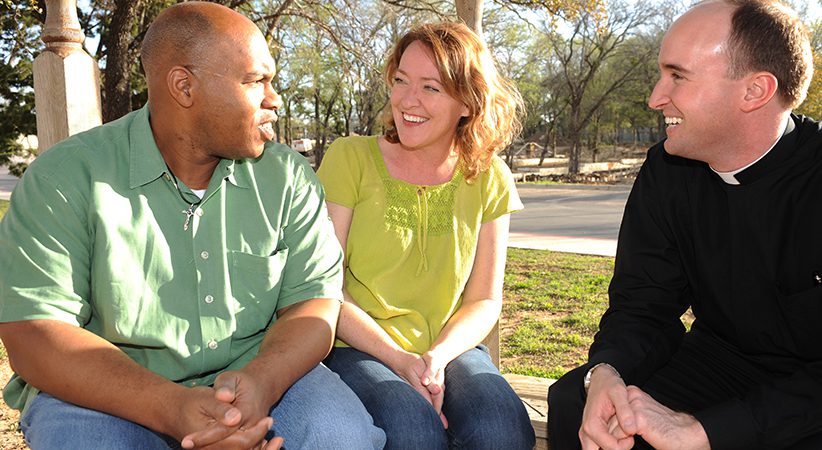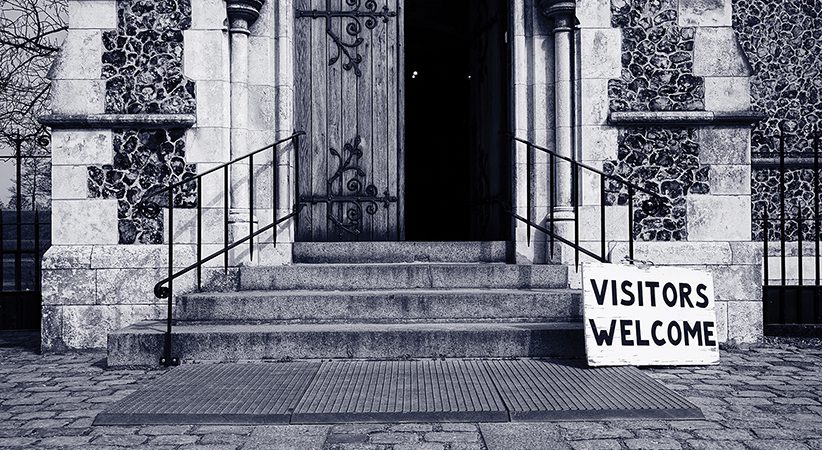The Beauty of Collaboration
Working together to build up the Church of tomorrow
Bishop David A. Zubik Comments Off on The Beauty of Collaboration
Change is rarely easy, especially in the Church. I know what that’s like, having grown up in the small town of Ambridge, Pennsylvania, where steel mills along the Ohio River forged many of the bridges, skyscrapers and ships that built and protected our nation. When Big Steel collapsed in the 1970s and ’80s and Pittsburgh’s population plunged, my hometown and its churches felt the effects.
The parish in which I was baptized, where I made my first confession, where I received my first Communion and confirmation; the parish in which I celebrated my first Mass after ordination to the priesthood and one of my first Masses after I was ordained a bishop, no longer exists. All five Ambridge parishes merged in the 1990s; today there is one parish.
Many communities in the Diocese of Pittsburgh continue to face the same hard realities that Ambridge experienced, including fewer people and dwindling resources. We live in a region where, in a number of communities, deaths have outnumbered births each year for more than two decades, with little of the immigration that swelled our population more than a century ago. Many families have moved from urban areas and mill towns to the suburbs.
But demographics aren’t our biggest challenge.
Responding to a Shifting Culture
As brother priests, you know that many Catholics have grown distant from Jesus. Too often, children raised in our parishes leave after confirmation. A recent study by Saint Mary’s Press of Minnesota, in collaboration with the Center for Applied Research in the Apostolate (CARA) at Georgetown University, found that of Catholics who leave the Faith, 74 percent said they left by age 20.
Many parents are not passing along the Faith. This reality is reflected in weekly Mass attendance and in the fact that participation in the sacraments has decreased 40 percent or more in our diocese since 2000. Elementary school enrollment is down 50 percent from two decades ago.
Yet, there are real signs of life and strong hope all around us as we are “On Mission for the Church Alive!” — the revitalization initiative I announced three years ago across the six counties of southwestern Pennsylvania. After much prayer, study and consultation, we are making changes that will shape our faith communities for generations to come. In an approach that requires collaboration, courage and compassion, we are taking ministry that was designed for the needs of the past and shaping it for the needs of today and tomorrow.
“On Mission for the Church Alive!” seeks to redesign our parishes and mobilize our people, engaging laity, clergy and religious alike to celebrate more vibrant liturgies, invigorate faith formation, re-energize evangelization, strengthen school and parish partnerships and, quite honestly, ultimately help each other get to heaven.
I am striving to mobilize our resources to rejuvenate parishes through ministries that lead people of all ages and backgrounds into a closer relationship with God. I want parishes that help heal the wounds of those who pray in our pews and that rebuild the broken relationships in our communities. I envision parishes that bring the Good News of God’s love and mercy to those who do not know him.
Preparation and Planning
Before launching “On Mission” in April 2015, I sought the expertise and support of a national consulting firm, Catholic Leadership Institute, which has a long history of working with us. The focus has been to renew and encourage clergy and lay leaders with the goal of better ministry and outreach. The vision of collaboration and consultation came from my own heart, as I thought about great leaders of the Church who have inspired me throughout my ministry.
After a year of prayer and study, hundreds of consultations were held across our four vicariates to review possible models and discuss the best ways for our parishes to come together to be strengthened. More than 30,000 people participated in these sessions and provided substantive feedback that has guided all planning.
| Prayer For ‘On Mission For The Church Alive!’ |
|---|
|
Father of Mercy,
as we journey “On Mission for The Church Alive!” endow us with your gifts of courage, collaboration and compassion. Help us to fulfill the mission of Jesus and his Church through vibrant parishes and effective ministries. Raise up selfless, energetic leaders to serve the Church in fidelity and with care. May we the Church of Pittsburgh in Allegheny, Beaver, Butler, Greene, Lawrence and Washington Counties be sustained and strengthened by your grace. Help us to learn Jesus, to love Jesus and to live Jesus. Hear this prayer and grant it through Jesus Christ our Lord, with the help of our dear Blessed Mother, under the mantle of her love. Amen. — Written by Bishop David A. Zubik |
The feedback from the laity showed that many understand the problems. They are concerned about the increasing demands on clergy. They recognize the need for better liturgies. Their greatest hope is that more young people will come to know Jesus and enkindle a relationship with the Church. They also are committed to caring for our aging parishioners and the poor among us.
The consultation continued with a lengthy review of all the feedback by the On Mission Commission, whose membership was nearly 90 lay leaders and some clergy. They created a set of recommendations of how parishes can best deliver vibrant sacramental celebrations, effective formation for discipleship and compassionate pastoral care for those in need. These recommendations were reviewed by our presbyteral and diocesan pastoral councils and were presented for my consideration. During this process I also met personally with each priest in active ministry to hear his concerns, hopes and vision for the future. Each priest and deacon also offered his insights via a very thorough survey followed by an individual meeting with representatives of the Clergy Personnel Board.
The Clergy’s Role
Following this rich consultation, I have placed our 188 parishes into 57 groupings that eventually will merge to form new parishes. Each grouping was assigned a timeline to work toward merger over a period of two to five years. I have announced assignments for all clergy, the maximum number of Masses per grouping based on the number of available priests, and am providing resources to guide clergy teams through this transition.
All of this relies on the continued collaboration of the clergy with me, with one another and with the laity of their parishes. We all are called and committed to working together, with our eyes fixed on Jesus, to accomplish his mission in each community.
Throughout this discernment process, our clergy have received support and training to develop the skills and tools they will need to lead in these new parishes. This has included priest and deacon collaboratives where they gather in prayer and mutual support to learn different styles and methods of leadership required in different circumstances. Clergy who are moving to new parishes will have nearly six months to meet with the clergy and laity in those parishes now and consider how to best approach their work.
Clergy teams will begin their assignments in October, focusing initially and solely on building relationships with their people in each and among the parishes in their particular grouping. They also will begin assessing parish ministries and staff before making adjustments that will allow them to develop a more vibrant parish. A basic blueprint will be provided as a tool to assist clergy and lay leaders with planning and building a parish focused on mission and discipleship.
Collaboration Is Key
Over the next several years, leadership teams in each parish grouping will create a plan for how best to become one parish, taking into account consultation with their faithful, including what sites and buildings to use, and submit those plans to me for final approval.
We are working to find and form more energetic lay leaders, commissioning them as lay ecclesial ministers who will collaborate with our clergy to lead the Church through succeeding generations. With more lay leaders serving in various ministries, priests will be able to focus on the spiritual care of the faithful, with the time to engage more “on-site” presence with their people that will help bring them closer to him.
As a parallel to “On Mission for the Church Alive!,” we are regionalizing all of our parish elementary schools into four geographical areas, in which every school will be supported by every parish in that region to ensure that families have access to Catholic schools that are academically excellent, spiritually alive and financially sustainable.
|
Like what you’re reading? Subscribe now.
|
Regionalization is intended to reinforce the schools’ Catholic identity and mission; reallocate resources to enhance student performance; stabilize enrollment; and enable greater collaboration in curriculum, technology, professional development, athletics and fundraising.
In addition, our parish-owned cemeteries are now being operated by a nonprofit cemeteries association that is providing expert management, lifting the administrative burden from pastors.
The Church Alive!
“On Mission for the Church Alive!” calls us to look at our communities as mission fields where we help bring people to Jesus and see our parishes as centers for worship, service and outreach.
The liturgy is the source and summit of a parish’s life. It should help motivate everyone present to live in a way that honors Jesus. Homilies that inspire personal transformation, music that is engaging and prayerful, and hospitality that truly welcomes is what I hope for in every parish. This will require close collaboration between clergy and laity and a deep commitment to invest in new strategies of leadership and ministry.
| See the Plan |
|---|
|
To learn more about
“On Mission for the
Church Alive!,” including
parish groupings,
clergy assignments and
reflections, visit
diopitt.org/OnMission. |
In a vibrant parish, religious education programs support parents in planting the seeds of faith that will grow in their children, helping them fall in love with Jesus and aspire to follow his teachings. I want to renew faith-formation programs so that children, youth and adults are introduced to or strengthened in their relationships with Jesus and the Church. I want to make disciples for Jesus.
This requires an approach to formation that fosters personal relationship with Jesus through Scripture, prayer and service. Strengthening evangelization efforts will help lead many others to be “coworkers in the vineyard of the Lord.”
All this change requires collaboration, courage and, especially, compassion. We must drop to our knees in prayer to ask the Holy Spirit to fire up our souls. We must pray to be less competitive and less protective of what we may think the Church is. We must accept the invitation of Jesus to be the Body of Christ, working in unison to bring his love and healing to others.
If Jesus can change simple bread and simple wine into his body and blood, if Jesus can rise from the dead, he can transform us and our parishes to fulfill his mission in the world.
When I breathe my last and I reach the pearly gates, I’m going to have to stand before the judgment seat of God. I’m sure he’s going to say to me: “David, I chose you to lead these people to me. What did you do to lead as many people as possible to me?”
That is a challenge all of us face; face it we must together, as the people whom God has called to be his Church. That is why we in Pittsburgh are “On Mission for the Church Alive!”
BISHOP DAVID R. ZUBIK is bishop of the Diocese of Pittsburgh.





